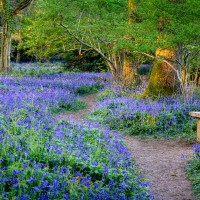Bluebells are a quintessentially British phenomenon, like drizzle and cream tea. Indeed, estimates put 50 per cent of the world’s bluebells in the UK – apparently they love the notoriously drizzly climate!
One of the keenest plants to shrug off the winter, the bluebell pokes its long, thin leaves out to lap up the sunlight before the trees can grow springtime leaves and block it out again. Arriving in swathes in the spring, the pretty blue flowers deliver a magical carpet to those same shady woodlands.
Bluebells are now a protected species, making it illegal to remove the bulbs from the wild. Meanwhile, British folklore has garlanded the flower with a string of fanciful attributes. They have been nicknamed ‘fairy flowers’ – in the belief that mischievous fairy folk used them as a trap for unwitting passersby (in particular, children). It was also thought that if you wore a wreath of bluebells around your neck, you would have to speak the truth.
These days, the native bluebell is under threat from a Spanish bluebell intruder that has infiltrated the bluebell’s habitats and hybridised with it.
Legend has it…
The bluebell’s scientific name hyacinthoides non-scripta comes from a Greek myth about Apollo and Prince Hyacinthus. One day when the two youths were playing discus, a jealous wind blew the discus off course so that it struck and killed the handsome Prince Hyacinthus. The grieving Apollo turned the Prince into a hyacinth flower, and as his tears spilled onto the petals of the new flower, they spelt out the word ‘alas’. The non-scripta part of the bluebell’s name means ‘unlettered’ to indicate that while the bluebell might look like a hyacinth, it is in fact a different species.
Budding Botanists’ Notebook
- Almost all of the bluebell’s flowers grow on one side of its stem, which gives it a distinctively gentle ‘nod’ in the breeze
- The most popular meaning given to bluebells is humility or gratitude, and it is also associated with everlasting love and constancy
- In Scotland, bluebells are also called harebells because it was believed witches turned into hares and hid among these flowers
- The sticky sap from bluebells was historically used to bind pages into the spines of books and to stick feathers on arrows
GLORIOUS GARDENS
Viewing Dates Late April to Early May throughout England, Wales and Ireland | September in the Southern Hemisphere
Cornwall
Located just outside the Cornish town of Bodmin, Lanhydrock is a perfect country house and estate with extensive gardens that deliver year-round colour. There are beautiful herbaceous borders, a fabulous formal parterre and colourful higher gardens filled with camellias, magnolias and rhododendrons, and a glorious bluebell trail. With ancient woodlands and tranquil riverside paths, there are also off-road cycle trails, with special routes for families and novice riders, and you can hire bikes for all ages when you arrive. It is also a great spot for flying a kite, playing conkers or climbing one of the glorious trees – yes, climbing is not only allowed, but encouraged!
Cumbria
Dorothy Farrer’s Spring Wood is filled with oak trees as well as ash, hazel, elm and alder, and – in the spring – bluebells carpet much of the woodland floor. You will also spy patches of wild garlic and early purple orchids as well as other wildflowers including violets, bramble and foxglove. In the sky above you will see – or at least hear the sounds of – pied and spotted flycatchers, warblers, woodpeckers, treecreepers and buzzards.
East Sussex
The famous Bluebell Express steam railway weaves in and out of the bluebells of East Sussex, running between Sheffield Park and East Grinstead. Glimpse them through the windows or hop off at one of the in-between stations for a closer look (a day’s ticket allows for unlimited travel).
Wiltshire
In Garston Woods in Wiltshire not only are the bluebells the English variety, but the flowers carpet the woodlands near the picturesque village of Sixpenny Handley. Follow the tracks through the woods and you will also get to see star-like wood anemones and even an orchid or two.
IRELAND
County Fermanagh
Belle Isle Estate – the grounds here are picture perfect with bluebells aplenty, and this estate has the added benefit of offering a castle you can exclusively hire.
EUROPE
Belgium
Halle Forest
AUSTRALIA
Sydney
Everglades Garden, Leura


